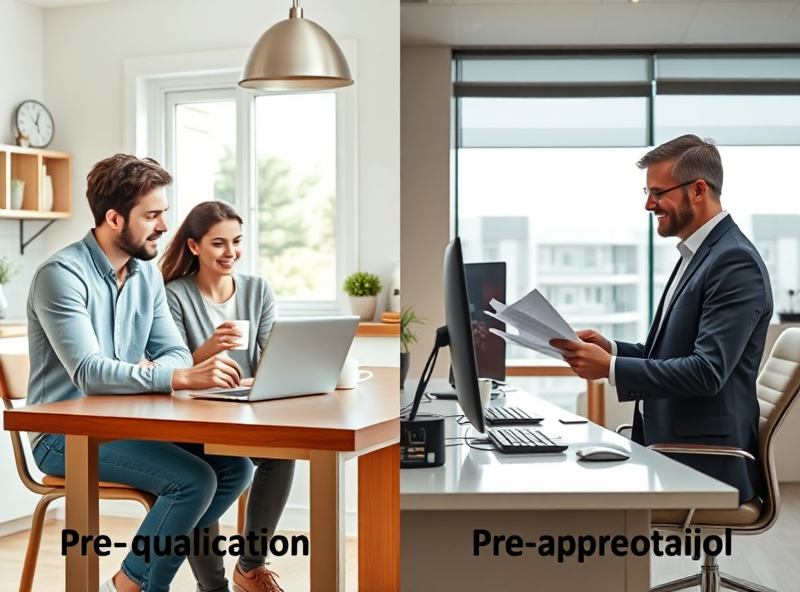
Pre-Approval vs. Pre-Qualification: The Key Differences That Affect Your Home Buying Journey

Buying a home is one of the most significant financial decisions you’ll make in your lifetime. Whether you’re a first-time homebuyer or a seasoned investor, understanding the mortgage process is essential. Two terms that often cause confusion are ‘pre-approval’ and ‘pre-qualification.’ While they may sound similar, they serve different purposes and can significantly impact your home buying journey.
In this article, we’ll explore the key differences between mortgage pre-approval and pre-qualification, how each affects your ability to purchase a home, and which one you should pursue first.
What is Mortgage Pre-Qualification?
Mortgage pre-qualification is typically the first step in the home loan process. It gives you a general idea of how much you might be able to borrow based on basic financial information you provide to a lender. This process is usually quick, often completed online or over the phone, and doesn’t require a hard credit check.
Lenders may ask for:
– Your income
– Estimated debts
– Employment status
– Basic credit information (self-reported)
Because this information is not verified, pre-qualification is considered a preliminary estimate. It’s useful for setting a budget and starting your home search, but it doesn’t carry much weight with sellers.
What is Mortgage Pre-Approval?
Mortgage pre-approval is a more in-depth process. It involves submitting a formal mortgage application and providing documentation for your financial situation. The lender will perform a hard credit inquiry and assess your creditworthiness based on verified data.
You’ll typically need to provide:
– W-2s or 1099s (usually from the past two years)
– Recent pay stubs
– Bank statements
– Tax returns
– Authorization for a credit check
Once approved, you’ll receive a pre-approval letter stating the amount you’re qualified to borrow. This letter is usually valid for 60 to 90 days and can give you a competitive edge when making an offer on a home.
Key Differences Between Pre-Qualification and Pre-Approval
| Feature | Pre-Qualification | Pre-Approval |
|————————–|—————————–|——————————-|
| Credit Check | No (soft or none) | Yes (hard inquiry) |
| Financial Verification | No | Yes |
| Time to Complete | Minutes to hours | Several days |
| Strength with Sellers | Low | High |
| Required Documentation | Minimal | Extensive |
Pre-approval is more reliable and shows sellers that you are a serious buyer with the financial backing to complete the purchase. Pre-qualification, on the other hand, is more of a starting point.
Which One Should You Get First?
Most experts recommend starting with pre-qualification to get a rough estimate of your budget. Once you’re ready to start house hunting seriously, you should move on to pre-approval. Having a pre-approval letter in hand can help you stand out in competitive markets, especially when multiple offers are on the table.
According to the Consumer Financial Protection Bureau (CFPB), getting pre-approved before shopping for a home can help you understand your loan options and prevent surprises later in the process.
Source: Consumer Financial Protection Bureau – https://www.consumerfinance.gov/
Benefits of Getting Pre-Approved
– Helps you determine your exact budget
– Makes your offer more attractive to sellers
– Speeds up the closing process
– Allows you to identify and fix credit issues early
Common Misconceptions
1. Pre-qualification guarantees a loan – It doesn’t. It’s only an estimate.
2. Pre-approval is a final loan approval – Not quite. Final approval comes after the home appraisal and underwriting.
3. You can skip pre-approval if you have good credit – Even with excellent credit, sellers prefer buyers with pre-approval letters.
Final Thoughts
Understanding the difference between pre-qualification and pre-approval can save you time, reduce stress, and improve your chances of securing your dream home. While both are valuable tools, pre-approval carries more weight and is often necessary in today’s competitive housing market.
If you’re serious about buying a home, start with pre-qualification to get a sense of your budget, then move on to pre-approval to show sellers you’re ready to buy.
Disclaimer
This article is for informational purposes only and does not constitute financial or legal advice. Mortgage processes and requirements may vary by lender and state. Always consult with a licensed mortgage professional or financial advisor before making any major financial decisions.








답글 남기기